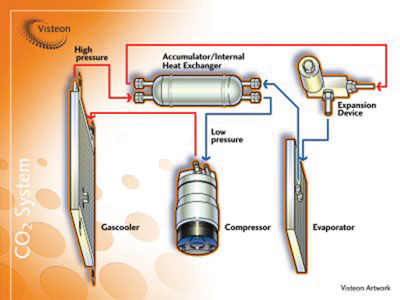When most people think of the U.S. in competition with Europe, it’s usually the Ryder Cup that comes to mind. The Ryder Cup is a golf trophy presented biennially to the winning players following the “Ryder Cup Matches” — a competition between teams from Europe and the United States. The match is held every two years and is played on courses alternating between the United States and Europe.
While the next Ryder Cup match won’t be until 2010 in Newport, Wales, another competition appears to be “heating up” between automakers from the U.S and Europe.
This one concerns which type of cabin cooling system will be used in new vehicles coming off the lines in 2011, replacing the current HFC-134a-based systems.
The reason? While HFC-134a is a “greener” hydrofluorocarbon refrigerant that replaced the ozone-depleting CFC-12 — which was phased out under the Montreal Protocol more than a decade ago — it still has a high global warming potential (GWP) of 1,430.
The Move to Phase Out R-134a
The Europeans have decided R-134a is bad for the environment and its effect on global warming issues. So, automakers there are working to develop a standard A/C system that will adhere to new European Union (EU) rules that will require all European vehicles equipped with A/C systems to use a refrigerant with a GWP rating of 150 or less. So far, the European automakers are moving forward with these plans to start phasing out R-134a in new vehicles by January 2011, and they will have until 2017 to completely eliminate R-134a systems from production.
In the U.S., California and about a dozen other states have also begun the challenge to demand lower refrigerant and tailpipe greenhouse gas emissions.
Mobile A/C manufacturers and suppliers have come up with a handful of alternative refrigerants for A/C systems that are available with GWP ratings of 150 or less. These include: R-744 (carbon dioxide, which has a GWP of 1), HFC-152a (a mildly flammable refrigerant with an acceptable GWP of 140) and a few blended refrigerants with GWP ratings under 150.
Did You Know?
Scientists assign “global warming potential” (GWP) numbers to a range of gases that vary according to its warming effect on the atmosphere. For a base reference point, CO2 has a GWP rating of 1. By comparison, R-134a refrigerant has a GWP of about 1,400. In other words, one pound of R-134a that escapes into the atmosphere has the same effect on global warming as the release of 1,400 lbs. of CO2. That’s why the EPA discourages venting, and encourages recovery and recycling of R-134a, as well as all other automotive refrigerants.
About two years ago, refrigerant suppliers introduced hydrofluoro olefin (HFO)-1234yf, which is considered to have the highest potential for replacing R-134a. This new refrigerant has a GWP rating of 4 and is not a blend.
Since the lead times required for new car designs can take years, global automotive manufacturers and suppliers have been working with industry experts and independent test laboratories since 2007, when the first SAE International Cooperative Research Program (CRP) was formed to investigate the safety and performance of HFO-1234yf for use in mobile air conditioning.
MACS 2009
During the Mobile Air Conditioning Society (MACS) annual convention and trade show held in early February at the Hilton Anatole in Dallas, the issue of commercialization of HFO-1234yf-based systems was addressed during a half-day technical session.
The educational session for journalists, technicians and A/C system suppliers was hosted by Dr. Stephen Andersen and Kristen Taddonio of the U.S. Environmental Protection Agency and Dr. Alberto Ayala of the California Air Resources Board. Featured speakers included Mary Koban of DuPont and Dr. David Wilson from Honeywell, representing the developers of this new refrigerant. The panel recapped some of the findings from the SAE meetings in 2007, as well as recent testing outcomes.
The refrigerant developers explained that HFO-1234yf has a very low GWP rating and claimed that air conditioning systems that use this formula are safe.
Koban said that DuPont was pleased that SAE International and leading automotive manufacturers have recognized the benefits of HFO-1234yf and that it has a dramatically lower global warming potential than the R-134a refrigerant used today. She also said that HFO-1234yf-based systems would be similar to R-134a systems, requiring little design changes for automakers. And, technicians familiar with R-134a systems would have little trouble servicing HFO-1234yf systems.
While the developers conceded that the new refrigerant and these A/C systems would have a slightly greater cost than current systems, there would be fuel cost savings to the driving public over the life of the vehicle due to improvements in A/C system design. Dupont and Honeywell researchers have said the new systems use less energy to operate, thereby providing improved vehicle engine efficiency that would allow 12 billion gallons of gasoline to be saved worldwide by 2025.
In December, SAE’s International CRP technical sessions, sponsored by major automotive manufacturers including Chrysler, Ford, General Motors, Fiat, Jaguar, Land Rover, Hyundai, PSA, Renault and Toyota, released a report summarizing results of its industry evaluation of HFO-1234yf. The report validated that HFO-1234yf is safe to use in mobile air conditioning, and that, of all the proposed alternatives considered, HFO-1234yf has significant environmental benefits. The report concluded HFO-1234yf offers “the greatest potential to meet environmental and consumer needs.”

However, two years ago, German automakers announced that they were moving ahead instead with R-744-based systems, and at this time appear to be holding steady to that position. Mercedes, BMW and Volkswagen/Porsche reported that they have decided against using HFO-1234yf in their vehicles, claiming that they felt there were safety risks with its use. While the German automakers would not elaborate on their concerns with HFO-1234yf, they did report that they completed their testing on the refrigerant’s capabilities last year.
The remaining automakers have a different point of view.
“All but four participants agree that HFO-1234yf is the refrigerant-of-choice to replace HFC-134a in motor vehicle air conditioning,” the U.S. EPA’s Andersen said. “The best estimate is that companies making 70% of air conditioned vehicles sold worldwide already consider R-1234yf to be the environmentally superior choice.”
Note: The summary SAE International CRP report is available online at: www.sae.org/standardsdev/tsb/
cooperative/altrefrig.htm.
What’s Next?
For now, no one seems to know if HFO-1234yf will be the refrigerant of choice used in U.S.-made vehicles anytime soon.
But A/C service equipment manufacturers we spoke to at the MACS show said once a formal decision is made from automakers, refrigerant identifiers and refrigerant reclaiming/recycling units capable of
servicing HFO-1234yf would be made available to technicians within months.
SAE has developed standards covering service equipment and technician service procedures for this new refrigerant.
And, the EPA was adamant in stating that current R-134a systems would not be retrofitted to handle HFC-1234yf refrigerant.
Since their announcement in 2006, the German automakers have stayed pretty mum on their R-744-based system research. However, various OE suppliers have demonstrated CO2 A/C systems in both Europe and the U.S. Their designs are different from R-134a systems in that they operate at higher pressures and need to include a heat pump to operate a fully functioning HVAC system in the vehicle.
However, R-744 system developers claim that CO2 air conditioners consume 25% less fuel than conventional R-134a systems, and enable a reduction of CO2 tailpipe emissions of up to 7g/km while operating the A/C system.
While there aren’t many answers when it comes to the future of cool, it has been raising some questions.
For example, what will aftermarket repair shops in the U.S. do when it comes time to service a customer’s German-made vehicle’s A/C system based on CO2 technology? Will independent repair shops have the training and equipment needed to service these high-pressurized R-744 systems, or will vehicle owners be forced to take their vehicles back to the dealership?
In other A/C-related news….
CARB Allows for Continued R-134a Sales in CA
Consumers and auto enthusiasts across the state claimed victory recently as the California Air Resources Board (CARB) voted in favor of adopting an alternative regulation that would keep automotive refrigerant (R-134a) available to Californians to recharge and service their vehicle’s air conditioning system, while at the same time reducing greenhouse gas emissions by nearly half a million metric tons.
The alternative regulation, proposed by the Automotive Refrigerant Products Institute (ARPI), and supported by the Automotive Aftermarket Industry Association (AAIA) and the California Automotive Wholesalers’ Association (CAWA) would allow R-134a to continue to be sold in California and will require a self-sealing can top; enhanced can labeling; a used can deposit and return program; and a consumer education campaign.
“What began more than two years ago as an effort to restrict sales and do-it-yourself use of the refrigerant R-134a, has resulted in CARB working with the leading companies and automotive aftermarket trade associations to craft a new four-tiered ‘hybrid’ mitigation plan that will allow the continued sale of refrigerants in the California market while ensuring proper handling and disposal,” stated Tom Brown, president of ARPI.
ARPI — representing leading refrigerant packagers like Interdynamics, Technical Chemical Corporation and EF Products (Quest brand) as well as AAIA and CAWA — has worked over a two-year period to craft a plan that replaces the originally conceived ban on the product.
“In an unprecedented collaborative effort with the automotive industry, CARB has shown great leadership and cooperation as we worked on a compromise solution,” said Aaron Lowe, vice president, Government Affairs, AAIA.
“This hard work by CARB and industry will ultimately benefit the thousands of California consumers, especially those low- and fixed-income families who purchase R-134a to cool their automobiles while limiting future emissions of refrigerant.”
These first AB 32 regulations will preserve the rights of both those who would or must work on their own vehicles to use, and retailers to sell these specialty products, often packaged with significant “value-added” enhancements like system lubricants, leak-stoppers, charging devices and pressure gauges. Additionally, the Environmental
Justice Advisory Committee found the impact of a ban would be disproportionately placed on lower and fixed income Californians, and as a result has supported the alternative proposal.












